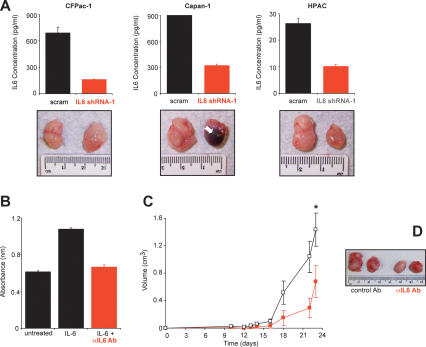Figure 4.
IL6 as a therapeutic target. (A) Knockdown of IL6 inhibits tumor growth. (Top panel) Reduction of IL6, as detected by ELISA from the conditioned medium of the indicated three human pancreatic cancer cell lines expressing IL6 shRNA-1, but not the scramble (scram) control counterpart. (Bottom panel) Representative tumors from the indicated three human pancreatic cancer cell lines stably expressing an IL6 shRNA-1 or scramble sequence after injection subcutaneously into the flanks of mice. (Arrow) Region of necrosis. (B) Neutralization of IL6 activity by an anti-IL6 antibody (αIL6 Ab). Cell numbers as measured by average absorbance ± standard error using the MTT assay 48 h after B9 cells were plated in serum-free medium (untreated), in the presence of IL6 to stimulate cell proliferation (IL6) or in the presence of IL6 and αIL6 Ab (IL6 + αIL6 Ab). (C) An IL6-neutralizing antibody inhibits Ras-driven tumor growth. Tumor volume (cubic centimeters) ± standard error versus time (days) of RasG12V-transformed human kidney cells growing in mice injected at the tumor site every 3 d with 100 μg of either the IgG1 control antibody (black box) or the IL6-neutralizing antibody (red box). (*) P < 0.01. (D) Representative tumors of RasG12V-transformed human kidney cells growing in mice injected every 3 d with 100 μg of either the IgG1 control antibody (control Ab) or the IL6-neutralizing antibody (αIL6 Ab).

